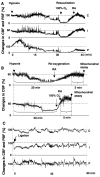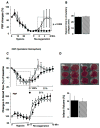The state of systemic circulation, collapsed or preserved defines the need for hyperoxic or normoxic resuscitation in neonatal mice with hypoxia-ischemia
- PMID: 20045241
- PMCID: PMC2814885
- DOI: 10.1016/j.resuscitation.2009.11.024
The state of systemic circulation, collapsed or preserved defines the need for hyperoxic or normoxic resuscitation in neonatal mice with hypoxia-ischemia
Abstract
Background: The return of spontaneous circulation (ROSC) is a primary goal of resuscitation. For neonatal resuscitation the International Liaison Committee on Resuscitation (ILCOR) recommends oxygen concentrations ranging from 21% to 100%.
Aims and methods: This study (a) compared the efficacy of resuscitation with room air (RA) or 100% O(2) in achieving ROSC in 46 neonatal mice with circulatory collapse induced by lethal hypoxia-ischemia (HI) and (b) determined whether re-oxygenation with RA or 100% O(2) alters the extent of HI cerebral injury in mice with preserved systemic circulation (n=31). We also compared changes in generation of reactive oxygen species (ROS) in cerebral mitochondria in response to re-oxygenation with RA or 100% O(2).
Result: In HI-mice with collapsed circulation re-oxygenation with 100% O(2) versus RA resulted in significantly greater rate of ROSC. In HI-mice with preserved systemic circulation and regional (unilateral) cerebral ischemia the restoration of cerebral blood flow was significantly faster upon re-oxygenation with 100% O(2), than RA. However, no difference in the extent of brain injury was detected. Regardless of the mode of re-oxygenation, reperfusion in these mice was associated with markedly accelerated ROS production in brain mitochondria.
Conclusion: In murine HI associated with circulatory collapse the resuscitation limited to re-oxygenation with 100% O(2) is superior to the use of RA in achievement of the ROSC. However, in HI-mice with preserved systemic circulation hyperoxic re-oxygenation has no benefit over the normoxic brain recovery.
Copyright 2009 Elsevier Ireland Ltd. All rights reserved.
Conflict of interest statement
Authors have no conflict of interest to disclose.
Figures



Comment in
-
Using 100% oxygen for the resuscitation of term neonates until evidence of spontaneous circulation: more investigations needed.Resuscitation. 2010 Feb;81(2):145-7. doi: 10.1016/j.resuscitation.2009.11.019. Epub 2009 Dec 29. Resuscitation. 2010. PMID: 20036456 No abstract available.
Similar articles
-
Monitoring of cerebral blood flow during hypoxia-ischemia and resuscitation in the neonatal rat using laser speckle imaging.Physiol Rep. 2016 Apr;4(7):e12749. doi: 10.14814/phy2.12749. Epub 2016 Apr 13. Physiol Rep. 2016. PMID: 27081159 Free PMC article.
-
Perivascular nitric oxide and superoxide in neonatal cerebral hypoxia-ischemia.Am J Physiol Heart Circ Physiol. 2008 Oct;295(4):H1809-14. doi: 10.1152/ajpheart.00301.2007. Epub 2008 Aug 1. Am J Physiol Heart Circ Physiol. 2008. PMID: 18676689 Free PMC article.
-
Rapid oxygen titration following cardiopulmonary resuscitation mitigates cerebral overperfusion and striatal mitochondrial dysfunction in asphyxiated newborn lambs.J Cereb Blood Flow Metab. 2025 Apr;45(4):630-642. doi: 10.1177/0271678X241302738. Epub 2024 Nov 22. J Cereb Blood Flow Metab. 2025. PMID: 39576879 Free PMC article.
-
Room air or 100% oxygen for resuscitation of infants with perinatal depression.Curr Opin Pediatr. 2009 Apr;21(2):188-93. doi: 10.1097/MOP.0b013e32832925b8. Curr Opin Pediatr. 2009. PMID: 19300260 Review.
-
Air or 100% oxygen in neonatal resuscitation?Clin Perinatol. 2006 Mar;33(1):11-27, v. doi: 10.1016/j.clp.2005.11.003. Clin Perinatol. 2006. PMID: 16533630 Review.
Cited by
-
Monitoring of cerebral blood flow during hypoxia-ischemia and resuscitation in the neonatal rat using laser speckle imaging.Physiol Rep. 2016 Apr;4(7):e12749. doi: 10.14814/phy2.12749. Epub 2016 Apr 13. Physiol Rep. 2016. PMID: 27081159 Free PMC article.
-
Nelfinavir inhibits intra-mitochondrial calcium influx and protects brain against hypoxic-ischemic injury in neonatal mice.PLoS One. 2013 Apr 22;8(4):e62448. doi: 10.1371/journal.pone.0062448. Print 2013. PLoS One. 2013. PMID: 23614049 Free PMC article.
-
Isoflurane anesthesia initiated at the onset of reperfusion attenuates oxidative and hypoxic-ischemic brain injury.PLoS One. 2015 Mar 23;10(3):e0120456. doi: 10.1371/journal.pone.0120456. eCollection 2015. PLoS One. 2015. PMID: 25799166 Free PMC article.
-
Hypoxic-ischemic injury in the developing brain: the role of reactive oxygen species originating in mitochondria.Neurol Res Int. 2012;2012:542976. doi: 10.1155/2012/542976. Epub 2012 Mar 22. Neurol Res Int. 2012. PMID: 22548167 Free PMC article.
-
Attenuation of oxidative damage by targeting mitochondrial complex I in neonatal hypoxic-ischemic brain injury.Free Radic Biol Med. 2018 Aug 20;124:517-524. doi: 10.1016/j.freeradbiomed.2018.06.040. Epub 2018 Jul 3. Free Radic Biol Med. 2018. PMID: 30037775 Free PMC article.
References
-
- 2005 International Consensus on Cardiopulmonary Resuscitation and Emergency Cardiovascular Care Science with Treatment Recommendations. Part 7: Neonatal resuscitation. Resuscitation. 2005;67:293–303. - PubMed
-
- Rootwelt T, Odden JP, Hall C, et al. Cerebral blood flow and evoked potentials during reoxygenation with 21 or 100% O2 in newborn pigs. J Appl Physiol. 1993;75:2054–60. - PubMed
-
- Solas AB, Kalous P, Saugstad OD. Reoxygenation with 100 or 21% oxygen after cerebral hypoxemia-ischemia-hypercapnia in newborn piglets. Biol Neonate. 2004;85:105–11. - PubMed
-
- Presti AL, Kishkurno SV, Slinko SK, et al. Reoxygenation with 100% oxygen versus room air: late neuroanatomical and neurofunctional outcome in neonatal mice with hypoxic-ischemic brain injury. Pediatr Res. 2006;60:55–9. - PubMed
-
- Solas AB, Kutzsche S, Vinje M, et al. Cerebral hypoxemia-ischemia and reoxygenation with 21% or 100% oxygen in newborn piglets: effects on extracellular levels of excitatory amino acids and microcirculation. Pediatr Crit Care Med. 2001;2:340–5. - PubMed
Publication types
MeSH terms
Grants and funding
LinkOut - more resources
Full Text Sources
Medical

